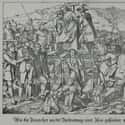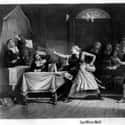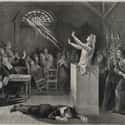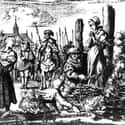-
(#6) MYTH: Witch Trials Only Happened in Salem
Even though Salem has nearly become synonymous with the witch hunts, people were being tried for being witches long before 1692. Between the 14th and 17th centuries, many countries in Europe carried out witch hunts resulting in the unjust executions of hundreds of thousands of people.
Throughout Europe, the Malleus Maleficarum, a book from the late 15th century that taught readers how to identify a witch, became widely popular and created an eager crop of witch hunters. In 1542, England passed a law called the “Witchcraft Act” that made the practice of witchcraft illegal and punishable by execution.
-
(#3) MYTH: It Was Mostly Teenagers Who Were Charged
Perhaps we have the popularity of Arthur Miller’s The Crucible to blame for the belief that many of the accused women were young, but in truth, older women, particularly wealthier widowed women with no male heirs and a lot of land to their name, were often accused of witchcraft. Scholars speculate that these women were considered threatening as powerful, independent women who no longer occupied the traditional roles of mother and wife. So, instead of letting these women live out the rest of their lives in peace, sometimes, very shortly after losing their significant others, their fellow villagers pointed fingers and cried “Witch!”
However, most of the accusers were teenage girls and young women.
-
(#7) MYTH: The Accused Faked Hallucinations
While some people have thought that the magical experiences the villagers experienced were faked, research suggests that they could have been caused by hallucinations from ergot-infected grain. Ergot is a fungus that infects rye, wheat, and other grains and can produce hallucinogenic effects similar to LSD if ingested, which could account for some of the magical things the colonists experienced. It could also explain their convulsions and other symptoms of illness.
Linnda Caporael, the scholar who suggested this theory, believes that infected grain likely caused the initial hallucinations. However, historians tend to agree that even if this theory is true, it doesn't explain away all the social and economic factors that led to finger-pointing during this time.
-
(#8) MYTH: Victims Were Executed at Gallows Hill
The infamous Gallows Hill might not be where the executions took place. In January 2016, The Gallows Hills Project, a group of Salem scholars, determined the exact location of the hangings to be Proctor’s Ledge.
With no records of eyewitness accounts, it took the group years of combing through court records, maps, and other evidence to find the location of the execution site, which historian Sidney Perley had already unofficially identified a century earlier.
-
(#5) MYTH: Humans Were the Only Victims of the Trials
If you thought people were the only victims of the witch hunts, you would be wrong. Man’s best friend was also a victim of the hysteria that ran rampant during the Salem witch trials.
After a young girl accused a dog of trying to bewitch her, the villagers shot the poor canine. Another dog was killed because it was thought to have been under the spell of an accused witch. Even the family pet wasn’t safe from the suspicions that gripped the Salem villagers.
-
(#1) MYTH: Accused Witches Were Burned at the Stake
While burning “witches” was a common practice during the European witch trials, no witches were burned during the Salem witch trials.
In Salem, the preferred method of execution was hanging. All of the witches who were convicted were hanged with the exception of Giles Corey, an 80-year-old man, who was pressed to death with boulders. This method was used to coerce defendants who refused to plead into talking.
New Random Displays Display All By Ranking
About This Tool
In the 1660s, the Salem Witch Trials took place in Salem Village in the Massachusetts colony. More than 200 people have been accused of witchcraft, a total of 19 innocent people were sent to the gallows. After several months, public opinion began to condemn the trial, and the new court reopened 20 cases. After that, the Massachusetts State Assembly reversed the convictions and compensated the families of the executed victim.
The 5 months trial in Salem was ridiculous and extremely cruel persecution. It was a scandal in American history. More than 300 years later, people built the Salem Witch Trial Memorial Park, and the names of those who died unjustly were engraved on the stones. The random tool tells 9 myths about the Salem Witch Trials.
Our data comes from Ranker, If you want to participate in the ranking of items displayed on this page, please click here.
















